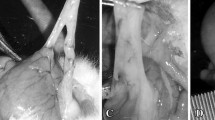Abstract
In an experimental study, the serosa of the ileum of rats was injured with silver nitrate, and the effect of topical application of a dexamethasone solution on subsequent formation of intraperitoneal adhesions was compared to the effect of saline irrigation (controls). There was a highly significant difference (p<0.01) in the incidence and grade of adhesions observed 1 and 4 weeks postoperatively between the control and dexamethasone-treated rats. Furthermore, adhesive intestinal strictures were observed in the control rats, but not in the animals that received dexamethasone. Administration of dexamethasone at the time of laparotomy and again 1 week postoperatively was most effective in preventing adhesions.
In a clinical trial, topical application of dexamethasone at the time of laparotomy for recurrent adhesive intestinal obstruction in 34 patients was associated with a 9% incidence of further recurrence of adhesive obstruction over a 1–6 year follow-up period, compared to a 31% incidence of recurrent obstruction in 13 similar patients who received only saline irrigation. Intraperitoneal administration of dexamethasone at the time of laparotomy and for the first 2 days postoperatively in 5 patients was followed by no recurrence of obstruction.
Résumé
La formation d'adhérences intrapéritonéales a été étudiée dans deux groupes de rats dont la séreuse iléale avait été lésée par du nitrate d'argent. L'application locale d'une solution de dexaméthasone a été comparée à un groupe témoin traité par simple irrigation au sérum physiologique. La fréquence et la gravité des adhérences sont, une et quatre semaines aprés l'opération, nettement moindres (p<0.01) chez les rats traités à la dexaméthasone que chez les témoins. On observe de plus, chez les témoins, des sténoses intestinales par adhérences, qui sont totalement absentes chez les rats traités à la dexaméthasone. Pour prévenir l'apparition des adhérences, les temps les plus efficaces pour l'administration de la dexaméthasone sont en cours de laparotomie avec réinjection une semaine plus tard.
L'application locale de dexaméthasone a été essayée en clinique, au cours de laparotomies pour obstruction récidivante par adhérences chez 34 malades: 9 % ont présenté de nouvelles récidives au cours des 1–6 années suivantes. Chez 13 malades traités uniquement par irrigation au sérum physiologique, la fréquence des récidives a été de 30 %. Chez 5 malades, la dexaméthasone a été administrée par voie intrapériton éale pendant la laparotomie et aux ler et 2ème jours postopératoires: aucun n'a présenté de récidive.
Similar content being viewed by others
References
Boys, F.: The prophylaxis of peritoneal adhesion. A review of the literature. Surgery11:118, 1942
De Sanctis, A.F., Schatten, W.E., Weckesser, E.C.: Effect of hydrocortisone in the prevention of intraperitoneal adhesion. Arch. Surg.71:523, 1955
Hubay, C.A., Weckesser, E.C., Holden, W.D.: The effect of cortisone on the prevention of peritoneal adhesions. Surg. Gynecol. Obstet.96:65, 1953
Belzer, F.O.: The role of venous obstruction in the formation of intraabdominal adhesions. An experimental study. Br. J. Surg.54:189, 1967
Connolly, J.E., Smith, J.W.: The prevention and treatment of intestinal adhesions. Surg. Gynecol. Obstet.110:417, 1960
Ellis, H.: The aetiology of postoperative abdominal adhesions. Br. J. Surg.50:10, 1962
Iijima, N., Yamamoto, T., Inoue, K., Gomi, F.: Experimental studies on intraabdominal adhesions. Postgrad. Med. J.46:278, 1970
Scheiberg, S.R., Saltzstein, H.E.: Effect of cortisone and corticotrophin (ACTH) on intraabdominal adhesions. Arch. Surg.63:413, 1951
Noble, J.B.: Plication of small intestine as prophylaxis against adhesions. Am. J. Surg.35:41, 1937
White, R.R.: Prevention of recurrent small bowel obstruction due to adhesions. Ann. Surg.143:714, 1956
Replogle, R.L., Johnson, R., Gross, R.E.: Prevention of postoperative intestinal adhesions with combined promethazine and dexamethasone therapy: Experimental and clinical studies. Ann. Surg.136:580, 1966
Eskeland, G.: The effect of prednisolone TBA on peritoneal absorption and exudation in rats subjected to a peritoneal trauma. Acta. Chir. Scand.125:337, 1963
Aboulafia, Y., Polishuk, W.Z.: Prevention of peritoneal adhesions by silicone solution. Arch. Surg.94:384, 1967
Ellis, H.: The cause and prevention of postoperative intraperitoneal adhesions. Surg. Gynecol. Obstet.133:497, 1971
Kaufman, N., Mason, J.E., Kinney, D.T.: The effect of steroids on fibroblast migration in vitro. Am. J. Surg.29:761, 1953
Luttwak, E.M., Behar, A.J., Saltz, N.J.: Effect of fibrinolytic agents and corticosteroid hormones on peritoneal adhesions. Arch. Surg.75:96, 1957
Zachariae, L.: Hydrocortisone acetate applied intraperitoneally. Acta. Endocrinol.19:269, 1955
Blucksman, D.L., Warren, W.D.: The effect of topically applied corticosteroids in the prevention of peritoneal adhesions. An experimental approach with a review of the literature. Surgery60:352, 1966
Author information
Authors and Affiliations
Rights and permissions
About this article
Cite this article
Shikata, Ji., Yamaoka, I. The role of topically applied dexamethasone in preventing peritoneal adhesions: Experimental and clinical studies. World J. Surg. 1, 389–393 (1977). https://doi.org/10.1007/BF01556870
Issue Date:
DOI: https://doi.org/10.1007/BF01556870




